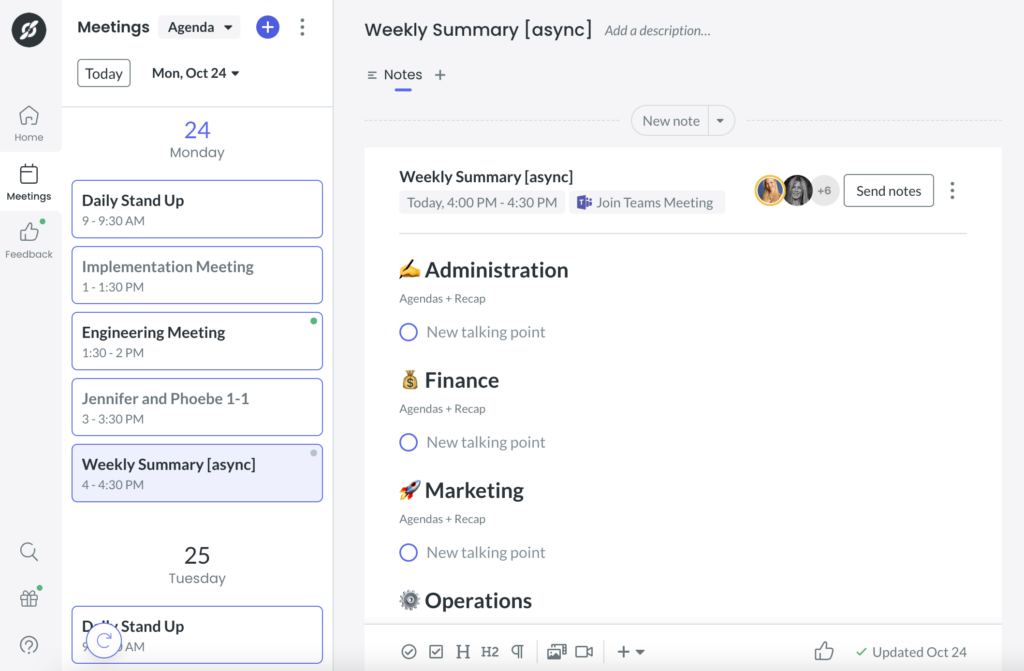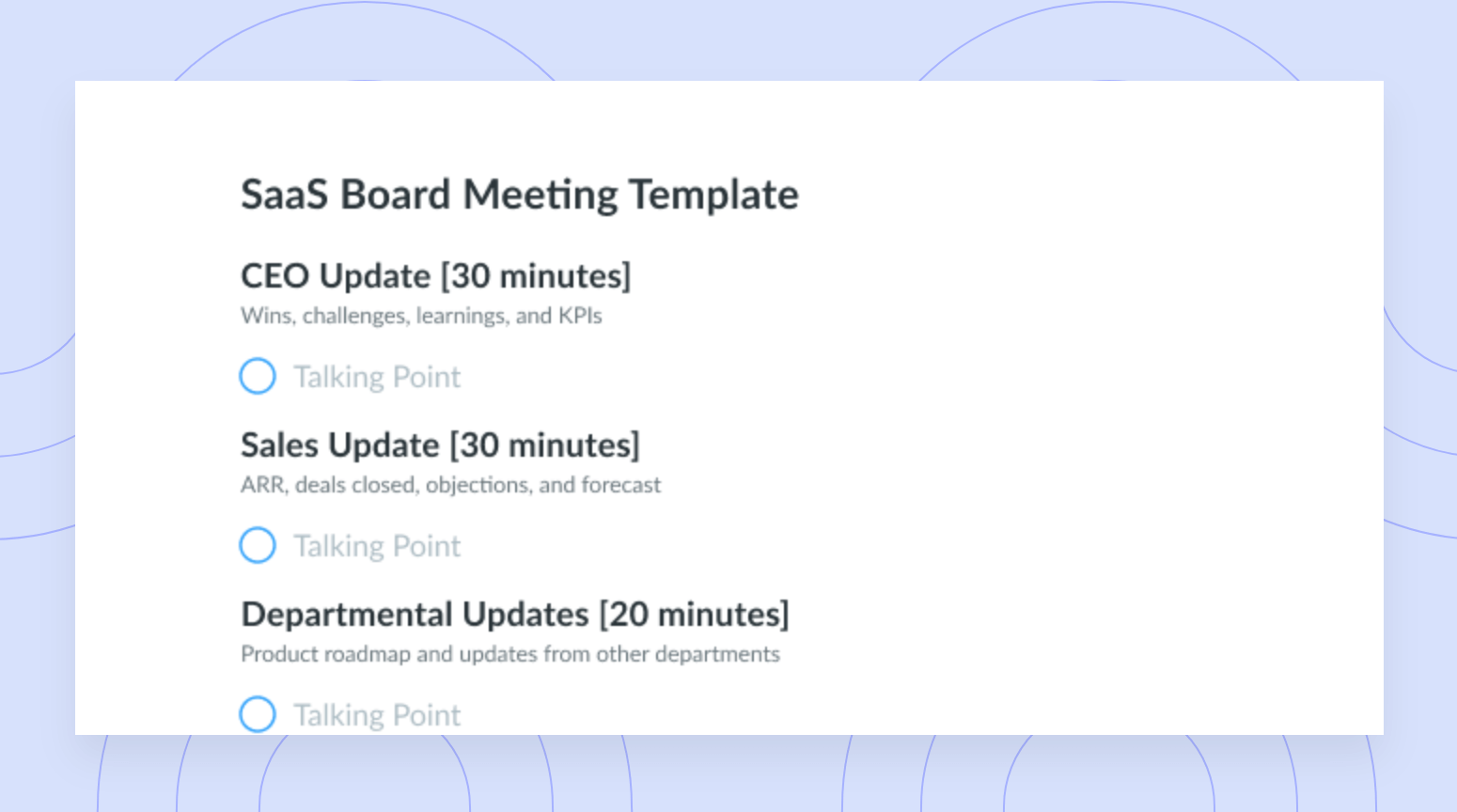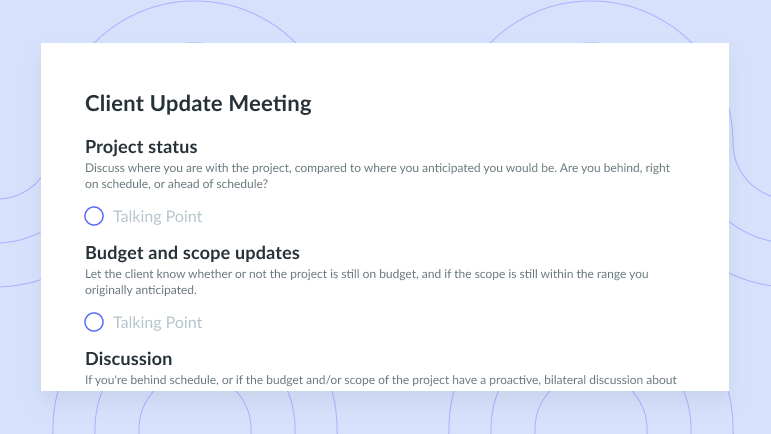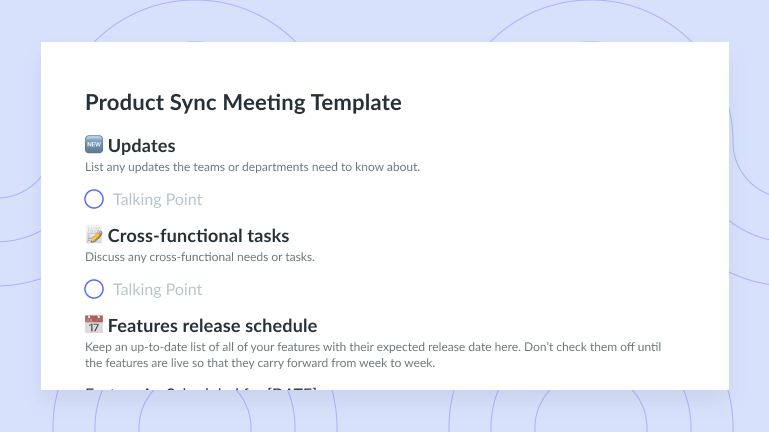What Is an Asynchronous Meeting? Your 2024 Guide
Asynchronous meetings don’t happen in real time. Learn how to run these meetings with clear communication.
It’s likely that one of the first things you do when you start your workday is check how many meetings you have on the calendar, what time they happen, and if they each have an agenda. A packed day of wall-to-wall meetings can really stifle one’s level of productivity and ability to work through their to-do list.
In fact, in the United States, there are around 55 million meetings held each week—that’s at least 11 million per day and over 1 billion per year, with an estimated $37 billion being lost per year to unproductive meetings.
What if you could take some of the meetings on your calendar and turn them into asynchronous meetings? It’s likely that you can—you just need to know how and be armed with meeting management software, like Fellow, to do it correctly.
- The definition of an asynchronous meeting
- The benefits of an asynchronous meeting
- The difference between synchronous and asynchronous meetings
- Examples of asynchronous meetings
- How to have an asynchronous meeting
- Frequently asked questions (FAQ) about asynchronous meetings
The definition of an asynchronous meeting
The asynchronous meeting meaning is a type of meeting that doesn’t take place live or in real time. Sometimes called non-live meetings or async meetings, asynchronous meetings allow participants to collaborate, share, and communicate with one another at a time that works best for them, at their own pace, and in their own time zones.
Usually, an asynchronous meeting takes place through pre-recorded or written communication, like through email, over business instant messaging software, or video messaging software. Since participants don’t need to be simultaneously available to participate, updates, comments, and responses from team members can take place at everyone’s convenience.

Experience seamless collaboration and enhanced productivity
Fellow.app streamlines the process of conducting, participating in, and following up on asynchronous meetings, ensuring effective communication and collaboration regardless of the participants’ locations or schedules.

The benefits of an asynchronous meeting
There are many benefits to holding asynchronous meetings. For starters, they’re time-zone flexible meetings, ideal for remote teams or employees on the opposite side of the world. When team members don’t live in the same time zone, finding a time in the workday to meet and share updates can be challenging. Instead, coworkers can take advantage of asynchronous meetings and share updates when it works best for them.
Additionally, having updates, comments, questions, and responses in a written format makes documentation easy to look back on for reference. Another important benefit to consider is that during an async check-in, no one is interrupted or cut off by someone hogging the meeting. Everyone is on an equal playing field and has time to contribute their input and share what’s most important to them.
The difference between synchronous and asynchronous meetings
There are key differences between synchronous and asynchronous meetings to keep in mind.
In a synchronous meeting, all attendees and participants have to be in one place at the same time, whether in person at the same location or virtually—in other words, there’s no wiggle room. But with an asynchronous meeting, attendees have more flexibility and freedom, which is especially great for remote collaboration across teams.
If you’re holding a synchronous meeting, you must consider location, timing, participant availability, and format. It can be stressful to find even 20 minutes where all attendees have time open on their busy calendars. If the meeting is in person, there are also elements like finding a meeting room with enough seating and the necessary tech for it all to run smoothly to consider.
With asynchronous meetings, it’s simple to let participants work together and collaborate effectively without checking that everyone is available simultaneously. There are no scheduling conflicts, and everyone can work at their own pace, gather their thoughts, and share updates when it’s convenient.
Examples of asynchronous meetings
There are many examples of types of meetings that work well in an asynchronous format.
Some examples of asynchronous meetings include:
- Asynchronous daily standup meetings: Just because they’re called standup meetings doesn’t mean everyone has to be in the same room, standing up and sharing. Instead, asynchronous standups provide a way to keep communication running smoothly between team members without adding another in-person or virtual meeting to everyone’s calendars. Instead, use a meeting collaboration tool like Fellow where everyone can add their updates in one place.
- Asynchronous weekly update meetings: Weekly update meetings often work as async conversations since the conversation typically sticks to critical updates and not asking for help or coming with specific questions. Participants share updates so everyone remains up to speed on how tasks are progressing.
- Asynchronous project status meetings: These types of meetings work well in an async format because participants can communicate and exchange updates on the many moving parts of a project at their own pace. This is especially simple using a tool like Fellow because updates can be documented in one place for everyone to access.
- Asynchronous retrospective meetings: Retrospective meetings are where attendees look back over a time period or a project and talk about what went well and what could have gone better. Having these async meetings gives attendees time to gather their thoughts before sharing, so they can better use the full time for discussion.
- Asynchronous team meetings: When the agenda is made up of updates, team meetings also work in an async format. Team members can let their team know what they’re working on at a time that works best for them, which is especially helpful if teams are spread out and working remotely.
How to have an asynchronous meeting
Watch Fellow’s Head of Marketing explain how she runs asynchronous team meetings:
If you’re new to async meetings, you can also follow this step-by-step process to conduct asynchronous meetings with your tip:
- Explain the benefits of asynchronous communication to your team
- Keep track of talking points and decisions
- Set a deadline to review the agenda and add notes
1Explain the benefits of asynchronous communication to your team
It’s important to explain the difference between synchronous and asynchronous communication to your team and the reason why you’ve decided to implement this new style of communication.
If your team members know that these changes to current processes are to give them more flexibility and more time to tackle their responsibilities, they’ll be much more excited to adopt this new way of communicating.
Most importantly, ask people for their opinion about this new approach and make sure to apply their suggestions.
2Keep track of talking points and decisions
Think about using a meeting notes app such as Fellow, so that you can type and store notes in the same place, keeping as organized as possible. You can refer back to your meeting notes to remind yourself of important deadlines, decisions or topics that you’d like to speak to at the next meeting.
One example of how we use Fellow to run asynchronous meetings are our daily asynchronous stand-up meetings, where different members of the team add talking points to the agenda to keep each other updated about their daily priorities. We realized it wasn’t necessary to have a video call every single morning, so we replaced our daily standup meetings with asynchronous check-ins instead. Here’s a sneak peek of the meeting agenda we use to run them:
3Set a deadline to review the agenda and add notes
One of the main benefits of asynchronous communication is higher flexibility (and fewer meetings on your calendar). However, even though asynchronous meetings don’t happen in real-time, it’s important to set clear expectations with your teammates about when the meeting agenda should be populated.
For the example above (daily asynchronous stand-ups), everyone is expected to populate their section of the meeting agenda by 10 AM every morning. This helps us ensure that everyone on the team stays up to date about each other’s priorities. The meeting notes on our agenda then become a historical record of the team’s work. That way, when we meet for our weekly team meetings, most people will already be caught up to speed and time will be used way more effectively.
Similarly, we use Fellow to run a weekly summary meeting, which everyone in the company is expected to populate with updates by 4 PM every Friday. Since our weekly summary notes are connected, we can look back at our updates and milestones from week to week.
Frequently asked questions about asynchronous meetings
Let’s answer some frequently asked questions about asynchronous meetings.
- Does asynchronous mean no meeting?
- What disadvantages does an asynchronous meeting have?
- How to encourage participation in an asynchronous meeting?
- What meetings should not be asynchronous?
1Does asynchronous mean no meeting?
The asynchronous meeting meaning doesn’t equate to no meeting at all; it means that the format is different. Instead of all attendees coming together in real time to discuss tasks and share updates, the updates are shared at a time that works best for everyone.
2What disadvantages does an asynchronous meeting have?
Although async meetings have many advantages, there are some disadvantages to consider. Some are:
- Longer turnaround time: Because of the lack of spontaneity and immediacy of async meetings, there is sometimes a delay in responses or communication. Also, an async meeting can make it take longer to decide on or implement action items.
- Less face time amongst team members: Since asynchronous meetings don’t offer the same opportunities for informal conversations or relationship building as live meetings do, colleagues may have more difficulty building rapport and healthy working relationships.
- No back-and-forth communication: Because these meetings don’t happen in real time, participants have to be extremely clear and detailed with their messaging, and there isn’t a back-and-forth taking place, which can be needed to ask questions or come to important decisions.
3How to encourage participation in an asynchronous meeting?
To encourage participation in asynchronous meetings, managers should set clear expectations for participation, establish deadlines for contributions, and encourage a culture of accountability.
Let team members know that just because these updates aren’t shared in real time, they’re just as important and can get everyone on the same page regarding important information.
4What meetings should not be asynchronous?
Not every meeting should take place asynchronously. Some that shouldn’t are:
- One-on-ones: The purpose of these meetings is to build trust and rapport between managers and their direct reports, so these meetings should happen in real time.
- Urgent decision-making meetings: When something is urgent and needs to be decided on, it’s best for everyone to meet at once.
- Performance reviews: Always make time for synchronous performance reviews as they help employees understand what they’re doing well, how they can improve, and what is expected of them in the future.
- Feedback meetings: Sharing feedback is important and should take place synchronously, especially when giving constructive criticism or negative feedback.
- Exit interviews: When an employee is leaving the organization, it’s important to meet with them in real time to learn why they have decided to part ways.
Parting advice
Sometimes, getting everyone in the same room, virtually or in person, is unnecessary for sharing updates. Once you understand the asynchronous meeting meaning and know how to implement this strategy correctly amongst your team, everyone will likely have more time throughout their day to work through essential tasks and to-do list items as well as focus on deep work.
![Asynchronous Communication Best Practices [+ Free Templates]](https://fellow.app/wp-content/uploads/2022/08/Asynchronous-Communication-2.jpg)
![Asynchronous Work: 7 Tips for Your Team [+ Free Template]](https://fellow.app/wp-content/uploads/2023/11/asynchronous-work-2.jpg)


























